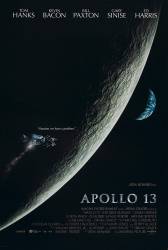Character mistake: When Marilyn asks Henry "Do they know they're not on the air?" her finger is pointing just below her face. In the next frame with the camera now facing the pair, her hand is down at her lap. (00:47:00)

Apollo 13 (1995)
1 character mistake
Directed by: Ron Howard
Starring: Tom Hanks, Ed Harris, Kevin Bacon, Bill Paxton, Gary Sinise
Factual error: Moments before and during the lift-off of the Saturn V, Ken Mattingly is shown to be watching from a somewhat private grassy field. Wherever he is supposed to be, he is far too close to the launch pad. No unauthorized persons were allowed to be that close, and certainly not in an undisclosed and unsupervised area, not the least of which was for security reasons. The fact that Mattingly is an astronaut would not give him carte blanch to do this, and his training and discipline would prevent his ever attempting doing so in the first place. In reality, Mattingly was in Houston at Mission Control at the time. Otherwise it is a nice shot.
Marilyn Lovell: Naturally, it's 13. Why 13?
Jim Lovell: It comes after 12, hon.
Trivia: The Apollo 13 mission set a record for the greatest distance from Earth ever achieved by mankind. This occurred because unlike the other Apollos, Apollo 13 did not make a burn behind the moon to drop into lunar orbit. The free-return trajectory the mission followed took the spacecraft farther behind the moon than any other mission.
Join the mailing list
Separate from membership, this is to get updates about mistakes in recent releases. Addresses are not passed on to any third party, and are used solely for direct communication from this site. You can unsubscribe at any time.
Check out the mistake & trivia books, on Kindle and in paperback.




Answer: Spacecraft re-enter Earth's atmosphere at extremely high velocity (thousands of miles per hour). Atmospheric friction slows the spacecraft descent somewhat; but, without parachutes, the Apollo spacecraft would still reach the surface traveling at hundreds of miles per hour. Landing in water at such high speed would be like hitting concrete, which would of course be instantly fatal. Hence the necessity of multiple parachutes. The Apollo program (and all early U.S. manned space programs) chose to land in the ocean for two reasons: 1) It was easier to track spacecraft re-entry from horizon-to-horizon at sea without visual and radar obstacles, and; 2) It was faster and easier to position several Navy vessels in the general splashdown location, then deploy helicopters to rapidly retrieve the astronauts and their spacecraft.
Charles Austin Miller